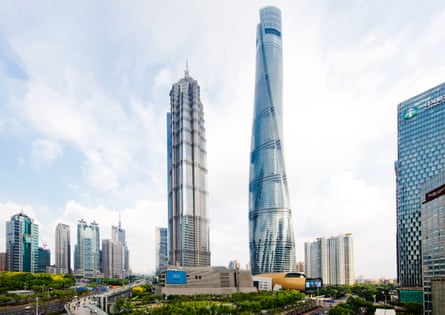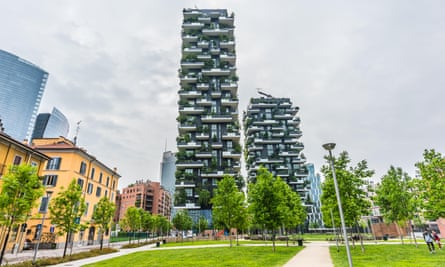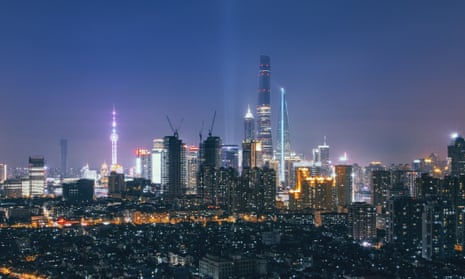Twisting high above Shanghai’s financial district, China’s tallest tower – and the second tallest in the world – is preparing to officially open its substantial doors to the public next month. The Shanghai Tower, reaching 632 metres, is the third “supertall” tower on the city’s iconic skyline. Looking out from the 119th floor, the city lies below like a toy model, a densely packed mass of streets and high-rise buildings.
China loves a world record, and its new building boasts plenty, including the world’s fastest elevators, highest hotel and restaurant, and tallest viewing platform. Reassuringly, it also required the largest ever cement pouring for the foundations. But most importantly, the 128-storey tower also claims to be the world’s greenest skyscraper. Awarded the top green rating, LEED Platinum, the government is hailing the tower as a sign of China’s growing green credentials.
China’s sustainability record in the past has been abysmal. The country burns 47% of the world’s coal, according to the US Energy Information Administration, and is facing the impact of decades of rapid deforestation and water pollution. With some of the most polluted air on the planet, killing as many as 4,000 people a day, an increasingly restive population is demanding more government action.
Nervous of the impact that smog-filled days and clogged roads could have on social stability, the government has begun tree planting programmes, ordered thousands of cars off the roads in cities such as Beijing, and is investing in green technology in a big way. China is now the biggest renewables market in the world, more than double than in the US, and home to almost one of every three wind turbines globally.
Green buildings, however, make up a woefully small part of the green industry, with most work focused on quick construction and quicker sales. Estimates put the number of green buildings on the mainland at less than 1%, though a 2014 target by the State Council wants 30% of new construction projects to be green by 2020.

In Shanghai, engineer Shunfu Cha points to 200 wind turbines spinning at the top of the tower – the world’s tallest turbines, naturally – which generate around 10% of the building’s electricity. “These are one of the most obvious green technologies,” he says, gesturing upwards into the clouds. “But only one part of bringing down the energy use.”
The building collects rainwater and re-uses waste water, has a combined cooling and heating power system and uses 40 other energy-saving measures that developers claim cut 34,000 metric tonnes from its annual carbon footprint. The building is wrapped in two layers of glass for natural cooling and ventilation, and in total developers say a third of the site is “green space”, including 24 sky gardens sitting between the two skins.
“At the moment, everyone is trying to achieve top green certification criteria,” says Xiaomei Lee, managing director of Gensler Shanghai, the building’s architect. “But nobody yet has achieved LEED Platinum for a supertall building. People assumed that a building of this size can’t achieve such a high sustainability rating.”
Shanghai Tower might be the only supertall tower to achieve LEED Platinum, but it is part of an increasing movement for towers to market green credentials as the demand for more sustainable urban development is felt.
The world’s first Passivhaus-certified office tower – a certification rating that considers ongoing annual energy use, considered more stringent than other energy codes – was opened in Vienna two years ago, using 80% less heating and cooling energy than an equivalent tower through efficient power systems. London’s tallest building, the Shard, also has a raft of sustainability features which enable it to use 30% less energy than a conventionally designed skyscraper of the same height. Globally, 75 skyscrapers are LEED rated.

More buildings are also turning green, literally. The Two World Trade Center development in New York has been designed to include a series of green terraces featuring different biozones. And in Milan, the Bosco Verticale is a pair of residential towers with 800 trees and thousands of plants on concrete balconies, maintained with recycled water. In Tel Aviv, plans for the Gran Mediterraneo tower include farms, vertical gardens and a range of fauna.
Advocates say that far from their reputation as polluters, skyscrapers offer environmental benefits. “Per capita, skyscrapers use less energy and water, generate less waste and provide for a more engaged living experience,” says Mahesh Ramanujam, chief operating officer at the US Green Building Council. “When properly developed, they also preserve and protect precious green space in urban markets.”
But the concept of “green skyscrapers” itself is controversial. Buildings are the largest contributor to climate change through carbon emissions, and critics point out that logically, taller towers will need more resources both to run and to construct. So are we just seeing the latest version of “greenwashing”?
Environmental concerns include the fact that clusters of towers can make the streets below dark, trapping hot air and pollution at ground level. There is a knock-on impact in terms of carbon emissions, blocking light to surrounding properties, forcing the need for more electric lighting and eradicating the possibility of solar energy.
Tall towers also face charges of elitism. News that London has 260 new skyscrapers in the pipeline met with bitter opposition from campaigners earlier this year, largely on the grounds that these towers will mostly offer luxury apartments that do little to help problems of affordable housing.
And money is certainly to be made in green development. Investors and companies are increasingly looking to benefit from cost efficiencies, with maintenance bills around 20% less than typical commercial buildings. While they cost more to build, the USGBC estimates most green projects pay for themselves in around seven years, especially as property agents say rents in LEED-certified buildings can be up to 30% higher.
The UN expects two-thirds of the world to live in cities by 2050 – the Chinese government’s target is 60% by 2020 – presenting challenges over how to provide sustainable buildings in space-starved cities. Research has suggested that high-rise buildings are the most sustainable form of urban development. A 2013 report by Terrapin Bright Green, commissioned by the New York government, recommended knocking down Manhattan towers that were too inefficient and replacing them with even bigger skyscrapers. Modern replacements could be 44% larger and still use 5% less energy, the study claimed.
While Terrapin acknowledged that demolishing and rebuilding wouldn’t be appropriate – or affordable – in every case, they found that even where buildings were knocked down and replaced, the energy needed to dismantle the existing building and construct a new one would still be offset within 15 and 28 years.
“Some people have opposed taller buildings on the premise that they use more energy, but they have failed to consider the larger spillover effects of urban sustainability that come from a dense urban fabric,” claims Sarene Marshall, executive director for the Center for Sustainability at the Urban Land Institute. “While buildings are the largest contributor to climate change through carbon emissions, transportation is a very close second. When you have a denser urban population, people are more likely to walk, bike or use public transportation to get to work. So if you build taller buildings, you have a denser urban fabric.

“If you build lower buildings and spread them out over a longer distance, what often happens is a much higher footprint in automobile transportation.”
A study by the New Climate Economy backs this up. Comparing the cities of Barcelona and Atlanta, with similar populations, Atlanta was found to have a much larger carbon footprint because people used cars to get around a large, sprawling urban area. The thinktank concluded that taller, denser buildings can dramatically reduce a city’s carbon impact.
However, green credentials and promises don’t always stack up. Critics say that LEED criteria focuses too much on the development of the building, and not enough on how it is used afterwards. A New Republic report claimed that The Bank of America tower in New York, hailed as the world’s most “environmentally responsible” office building when it opened in 2010, actually produces more greenhouse gases and uses more energy per square foot than any comparably sized office building in Manhattan. In relying too much on LEED ratings, critics argue, developers and governments can get additional publicity without necessarily being energy efficient in the long run.
In many US states, there are also tax breaks for energy-efficient buildings, leading to claims that building designers target the easiest and cheapest green points in order to qualify as LEED rated and gain tax exemptions.
And there are cases where the new technology disappoints. In London, the Strata Tower in Elephant and Castle, met criticism by residents when it opened as its in-built wind turbines – designed for helping heat and cool the building properly – weren’t turning. “I feel like I’m in an eco experiment that has gone wrong at the design stage”, one resident said. The promised new public garden at the Walkie Talkie tower in London also attracted criticism for being neither particularly green nor public enough.
For advocates of high-rise buildings, vertical development seems to be the future, and they remain convinced that green skyscrapers like the Shanghai Tower are the only sustainable way to do it. Sceptics will be watching closely for evidence that their optimism is not unfounded.
Follow Guardian Cities on Twitter and Facebook to join the discussion

Comments (…)
Sign in or create your Guardian account to join the discussion